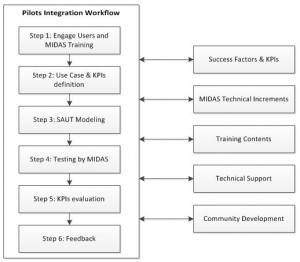Integration Strategy for the Pilot Activities
MIDAS partners have defined the integration strategy for the pilot activities.
The integration strategy for the pilot activities tries to schedule, following the same approach of the Technical Integration Plan of MIDAS, the set of tasks and increments from the pilots’ point of view, in particular, provides:
1. a schedule with concrete steps for developing an increment in the context of a pilot,
2. the definition of increments that are produced during the pilots,
3. the definition of the interaction with the technical milestones included in the Technical Integration Plan,
4. the collaboration with the standardization activities and,
5. the collaboration with the bootstrapping of the MIDAS Community.
Context of Pilots in the MIDAS Project
In the MIDAS project terminology, the term Pilot identifies a complex, service oriented software system deployed on a business infrastructure that solves a set of common use cases in typical industrial scenarios. The pilots are thought to be realistic representations of what could be a typical client for the MIDAS platform.
The pilots are the way to validate the hypothesis (Reduction of overall R&D and maintenance cost, improvement of Quality of SUT, compared to MBTA and TTA) in practice with real IT systems.
The two pilots in the Healthcare and Supply Management Chain aim at demonstrating this assumption by providing each a plausible yet simplified business scenario where complex service oriented architectures are employed. External companies, in particular SMEs, will be engage to participate in the pilots activities to obtain a valuable feedback and evaluate the potential exploitation of MIDAS results at an early stage.
Integration Strategy
Following the same approach as the Technical Integration Plan, the pilots’ activities will be performed in an incremental and step-by-step manner. With each increment, the pilots will make use of a more mature MIDAS platform, more training contents will be available and the skills and technical knowledge requirements of external stakeholders will be decreasing. This way, the hypothesis is that we should have an evolution in the cost and benefit curves, so that the latest increments will have more benefits for less costs. The integration strategy defines six steps as part of a pilot increment, and five auxiliary steps.
 Overview of the major MIDAS Pilots integration Steps
Overview of the major MIDAS Pilots integration Steps
The main idea of the workflow suggest that an increment is a full automated testing of a SAUT concluding with the feedback from technical, socio-economic and adoption perspectives. It starts from an engagement and training sessions in order to know how-to use MIDAS, in practice, how to model the SAUT. Then, a concrete use case and particular KPIs for the increment are defined. Then, the end-users make use of the MIDAS platform, ideally without the need of any consultant, so they can create the SAUT model and perform the test. Finally an evaluation according to defined KPIs is done and feedback is given to the consortium in terms of bugs, new features, barriers, success factors and in the potential adoption of the technology in practice.
Meanwhile, the five auxiliary steps work towards these major goals:
• Give empirical data for the success factors and KPIs defined. Potentially add more factors or KPIs.
• Compare the evolution of the MIDAS increments in practice, in particular, by finding more defects as the test methods are improved
• Improve training contents to reduce the learning curve for the MIDAS adoption.
• Request new features (i.e. reverse engineering of WSDLs and data types) and obtain support in case bugs are found.
• Add more stakeholders and promote the bootstrapping of the MIDAS community.